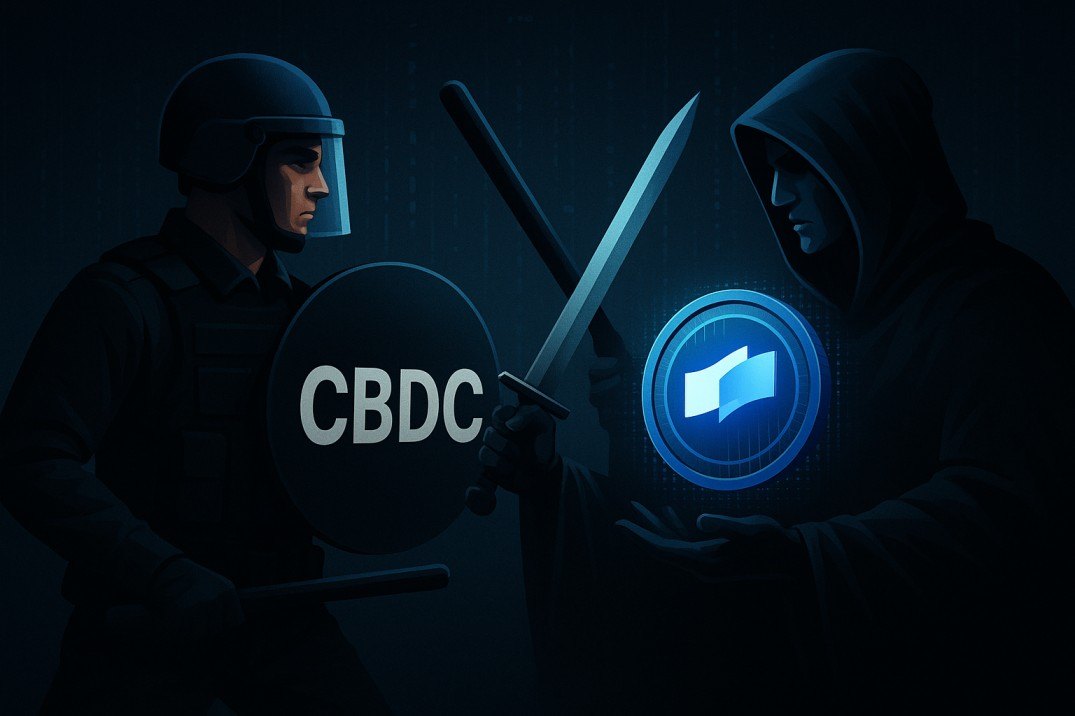TL;DR
- Central Bank Digital Currencies (CBDCs) are moving closer to launch, with projects like the ECB's Digital Euro and Bank of Israel's Digital Shekel already in testing.
- CBDCs face a core tension: offering transparency for regulators while protecting user privacy.
- COTI is one of the only blockchain networks actively shaping CBDC privacy through its Garbled Circuits technology.
- By working with the ECB and Bank of Israel, COTI is proving its hybrid design - confidentiality without anonymity - can balance adoption and compliance.
- The future financial landscape could see a clash between state-controlled CBDCs and privacy-first chains. COTI is positioning itself to sit at the center of that debate.
The idea of government-backed digital money has shifted from concept to inevitability. Central Bank Digital Currencies, or CBDCs, are now at the core of global financial experiments. From China's Digital Yuan to the European Union's Digital Euro, governments are trying to update cash for the digital age. But a question hangs over the entire project: Can CBDCs balance control and privacy?
This isn't a minor detail. Without strong privacy protections, citizens may reject CBDCs outright, viewing them as surveillance tools. At the same time, regulators demand compliance mechanisms that prevent CBDCs from becoming dark-money alternatives.
This is where COTI steps in. Its hybrid blockchain design, built around Garbled Circuits, is already being tested in official CBDC pilots. Unlike most crypto projects, COTI is not just speculating on how CBDCs might work - it's inside the room, building the infrastructure with central banks.
CBDCs: Between Innovation and Control

CBDCs promise a lot. Faster payments, cross-border settlement, programmable money, and financial inclusion. But they also come with new risks.
For governments, CBDCs mean better oversight of money flows. For individuals, they risk handing too much visibility to institutions. Imagine every purchase tracked in real time - from groceries to donations. Without privacy rails, CBDCs could erode financial freedom. The European Central Bank has been clear about this tension. In their Digital Euro studies, they note that adoption depends on striking a balance between usability, regulation, and privacy. If the Digital Euro feels like surveillance, people won't use it.
This is why COTI's role is important. Its model of "confidentiality without anonymity" could be the missing piece that makes CBDCs acceptable to the public.
COTI's Work with the ECB: Building the Digital Euro
In May 2025, the European Central Bank selected COTI as a Pioneer Partner in its Digital Euro project. Alongside firms like Accenture, KPMG, and Tata, COTI was chosen to explore privacy solutions for the Eurozone's CBDC.
The focus here is conditional payments - the ability to verify assets before exchange. In practice, this means ensuring a transaction is legitimate without exposing sensitive user details.
COTI's Garbled Circuits allow exactly that. They let smart contracts process private data without revealing it, ensuring accuracy while preserving confidentiality. For the ECB, this is a way to pilot privacy-preserving payments in line with European regulations.
The Digital Euro is slated for 2026. Between now and then, infrastructure partners like COTI will be critical in shaping what the final system looks like.
The Bank of Israel's Digital Shekel: COTI in Action
COTI's involvement with central banks didn't start in Europe. In July 2024, it was also chosen for the Bank of Israel's Digital Shekel project.
Here, COTI worked alongside names like PayPal and Fireblocks to test advanced functionalities for CBDCs.
For Israel, the challenge was the same as Europe's: how to make CBDCs secure, cost-effective, and private enough to win trust. COTI's Garbled Circuits were tested as a cheaper, more scalable alternative to other privacy systems like Zero-Knowledge Proofs.
This gave COTI a real-world sandbox to refine its technology, placing it ahead of most blockchain projects in the CBDC race.
Garbled Circuits: The Privacy Engine
To understand why COTI keeps getting invited to CBDC tables, you need to understand Garbled Circuits (GCs).
Originally developed in academia, GCs allow two or more parties to compute on private data without revealing it. Think of it like running a math equation where each side inputs secret numbers, but no one ever sees the other's input - only the verified result.
In COTI's case, Garbled Circuits are implemented on-chain. This makes them ideal for conditional payments, CBDC transfers, and confidential financial transactions.
Compared to other privacy methods, GCs have some advantages:
- Efficiency: They run on consumer-level devices, not just high-end hardware.
- Lower Costs: Simpler computations mean cheaper transactions.
- Regulatory Flexibility: They provide confidentiality while still allowing compliance checks where needed.
The result is privacy that doesn't clash with regulation - a critical requirement for CBDCs.
Confidentiality Without Anonymity
This phrase is key to COTI's positioning. Pure anonymity (like Monero or Tornado Cash) scares regulators. But full transparency scares users.
COTI's model offers a third way: transactions are confidential to the public but can be audited under defined legal conditions. This is what makes it attractive for CBDCs. Institutions can reassure citizens that their everyday transactions won't be tracked in detail, while regulators still maintain oversight where required.
In practice, this balance may be the only way CBDCs gain widespread adoption.
The Coming War: CBDCs vs Privacy Chains

As CBDCs roll out, they will compete directly with crypto privacy projects. On one side, you'll have state-backed systems designed for compliance and control. On the other, decentralized privacy coins and chains promising freedom from surveillance.
Projects like Monero, Zcash, and even Bitcoin with privacy layers will position themselves as alternatives. But they'll face regulatory pushback.
COTI sits uniquely between the two camps. It's a privacy chain that also works with regulators. Instead of rejecting CBDCs, it's helping build them in a privacy-preserving way. This hybrid role could make COTI indispensable. If governments adopt CBDCs but citizens demand privacy, COTI becomes the bridge. If regulators push back against full-anonymity chains, COTI's model remains viable.
Risks and Challenges
Of course, nothing is guaranteed. CBDCs are politically charged. Critics argue they could expand government surveillance. Technical hurdles also remain - from scalability to interoperability with existing banking systems.
For COTI, the challenge is proving that Garbled Circuits scale in real-world CBDC volumes. Another risk is regulatory shifts: if governments decide privacy is too risky, even COTI's balanced model may face limits. But the flip side is clear: without privacy, CBDCs may fail to launch at all. That leaves COTI in a strong position to influence outcomes.
Why COTI Matters for the Next Crypto Chapter
Crypto's early story was about decentralization. The next chapter may be about coexistence with institutions.
CBDCs are coming whether the crypto community likes it or not. The real battle will be whether they are adopted in a way that respects user privacy.
COTI is one of the few projects not only talking about this - but actively building inside it. With its involvement in the ECB and Israel pilots, it has credibility no other privacy chain can match.
That makes it highly relevant for the decade ahead.
Final Thoughts
The war between CBDCs and privacy chains is not a far-off possibility - it's already here. Governments are accelerating CBDC rollouts. Privacy chains continue to innovate. Somewhere in the middle lies the real future of digital money.
COTI, through its hybrid design and Garbled Circuits technology, is carving out a role few others can. By delivering confidentiality without anonymity, it's showing central banks that privacy and compliance don't have to be enemies. The Digital Euro, Digital Shekel, and beyond will test this balance. If successful, COTI could become not just another blockchain project, but a cornerstone of how money works in the digital age.
ALSO READ: 5 Crazy Ideas That Could Be Built on COTI (But No One Has Yet)











